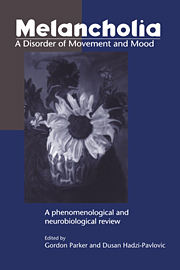Book contents
- Frontmatter
- Contents
- List of contributors
- Acknowledgments
- Introduction
- Part One Classification and Research: Historical and Theoretical Aspects
- Part Two Development and Validation of a Measure of Psychomotor Retardation as a Marker of Melancholia
- 5 Psychomotor Change as a Feature of Depressive Disorders: Historical Overview and Current Assessment Strategies
- 6 Development and Structure of the CORE System
- 7 Reliability of the CORE Measure
- 8 Validity of the CORE: I. A Neuroendocrinological Strategy
- 9 Validity of the CORE: II. Neuropsychological Tests
- 10 Validity of the CORE: III. Outcome and Treatment Prediction
- 11 Phenotypic Expression of Melancholia Contrasted for Those with Bipolar and Unipolar Illness Courses
- 12 Psychotic Depression: Clinical Definition, Status and the Relevance of Psychomotor Disturbance to Its Definition
- 13 A Clinical Algorithm for Defining Melancholia: Comparison with Other Sub-typing Measures
- 14 Rating the CORE: A User's Guide
- Part Three The Neurobiology of Melancholia
- The CORE Measure: Procedural Recommendations and Rating Guidelines
- References
- Author Index
- Subject Index
7 - Reliability of the CORE Measure
from Part Two - Development and Validation of a Measure of Psychomotor Retardation as a Marker of Melancholia
Published online by Cambridge University Press: 04 August 2010
- Frontmatter
- Contents
- List of contributors
- Acknowledgments
- Introduction
- Part One Classification and Research: Historical and Theoretical Aspects
- Part Two Development and Validation of a Measure of Psychomotor Retardation as a Marker of Melancholia
- 5 Psychomotor Change as a Feature of Depressive Disorders: Historical Overview and Current Assessment Strategies
- 6 Development and Structure of the CORE System
- 7 Reliability of the CORE Measure
- 8 Validity of the CORE: I. A Neuroendocrinological Strategy
- 9 Validity of the CORE: II. Neuropsychological Tests
- 10 Validity of the CORE: III. Outcome and Treatment Prediction
- 11 Phenotypic Expression of Melancholia Contrasted for Those with Bipolar and Unipolar Illness Courses
- 12 Psychotic Depression: Clinical Definition, Status and the Relevance of Psychomotor Disturbance to Its Definition
- 13 A Clinical Algorithm for Defining Melancholia: Comparison with Other Sub-typing Measures
- 14 Rating the CORE: A User's Guide
- Part Three The Neurobiology of Melancholia
- The CORE Measure: Procedural Recommendations and Rating Guidelines
- References
- Author Index
- Subject Index
Summary
Introduction
We provide an overview of two studies examining the reliability of the CORE II measure in the hands of clinicians (with a comparison of ratings made by relatives and by psychiatrists having been reported in Chapter 6). The first (MDU) study was undertaken by the consultant psychiatrists involved in the development of the core measure. There is a risk to any such endeavour – in that the consultants, as experienced clinicians, may rate on the basis of clinical intuition (i.e., they might observe a patient, “smell” melancholia, and “rate up” on the core system – or conversely “rate down” when assessing non-melancholic depression), bringing about invalid agreement between core ratings. The second (NIMH) study, involving non-MDU staff, provided an opportunity to overcome any “intellectual incest” or related bias, in addition to allowing the reliability of the core system to be tested for non-psychiatrists and from video (rather than live) interviews.
Methods
The MDU Study. Shortly after designing the CORE II schedule, we commenced an inter-rater reliability study. The procedure involved one of five consultant psychiatrists (HB, PB, IH, PM and KW) interviewing a depressed patient for at least 20 minutes, with two or more of the other consultants observing the interview. At completion, each consultant made an independent rating of all core signs, ratings were reviewed and disagreements were discussed in detail.
- Type
- Chapter
- Information
- Melancholia: A Disorder of Movement and MoodA Phenomenological and Neurobiological Review, pp. 130 - 137Publisher: Cambridge University PressPrint publication year: 1996

